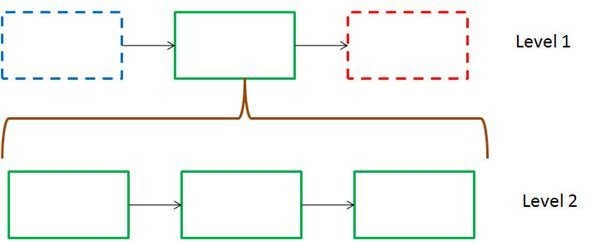Six Sigma Project Management: Understanding Core Processes & Hierarchical Process Maps
Creating hierarchical process maps is accomplished using a systematic procedure. For any given level we want our process maps to be fairly simple, consisting of only 3-5 steps. The individual steps at this level are sometimes referred to as a company’s Core processes.
The Level 1 Process
First we start at Level 1, representing the overall organization.
For example, a company that manufactures and sells software might have a Level 1 process that looks something like this:
Create Product -> Sell Product -> Provide Support
This map doesn’t tell us much about how each step is performed, but at the highest levels of the organization, leaders are concerned with performance at this scale. They want to know how effectively each part of the process is being accomplished and will expect action to be taken if performance is not up to expectations or requirements.
The Level 2 Process
Once the Level 1 process has been clarified, each step in the process is expanded into another process map of 3-5 steps showing how that piece of the business is carried out. For instance, our example company would create a process map for Step 2 of the Level 1 process: Sell Product. It might resemble this example:
Market Product -> Take Orders -> Deliver Product
These steps might correspond to different departments or divisions of a company, each responsible for performance of that operation.
Processes For Subsequent Levels
We continue drilling down each step in the process to create the next-level process, until it no longer makes sense to do so.Typically at least three levels are required, even for small businesses, while large corporations often have more than three levels.
In the next article in this series we will look at tying performance metrics to the processes at each level. These metrics are tracked continuously and action is taken when performance does not meet goals, in some cases by launching a process improvement project or at least establishing a project schedule hierarchy.
This post is part of the series: Establishing a Business Process Management System for Six Sigma
A business process management system(BPMS) is an effective means of managing and measuring business performance. It involves understanding your processes at different levels, establishing metrics for the business and subgroups, and using metrics to identify when process improvement is necessary.
- Formulating Your Company’s Processes and Values: Getting Started in Business
- BPMS: Core Processes and Hierarchical Process Maps
- BPMS Metrics for Business Dashboards
- Business Process Management System, Part 4: Metrics For Balanced Scorecards
- Business Process Management System, Part 5: Project Selection & Prioritization
